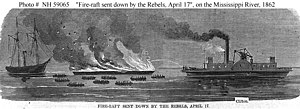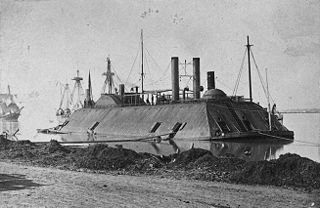
USS Essex was a 1000-ton ironclad river gunboat of the United States Army and later United States Navy during the American Civil War. It was named for Essex County, Massachusetts. USS Essex was originally constructed in 1856 at New Albany, Indiana as a steam-powered ferry named New Era.
The first USS Arizona was an iron-hulled, side-wheel merchant steamship. Seized by the Confederate States of America in 1862 during the American Civil War, she was captured later the same year by the United States Navy.
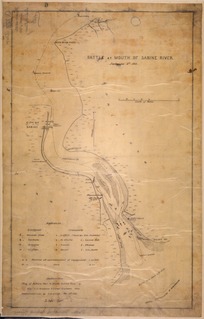
The Second Battle of Sabine Pass was a failed Union Army attempt to invade the Confederate state of Texas during the American Civil War.

The USS Queen of the West was a sidewheel steamer ram ship and the flagship of the United States Ram Fleet and the Mississippi Marine Brigade. It was built at Cincinnati, Ohio in 1854. It served as a commercial steamer until purchased by Colonel Charles Ellet Jr. in 1862 and converted for use as a ram ship. The ship operated in conjunction with the Mississippi River Squadron during the Union brown-water navy battle against the Confederate River Defense Fleet for control of the Mississippi River and its tributaries during the American Civil War.
USS Westfield was a sidewheel steam ferryboat in the United States Navy during the American Civil War.
USS Henry Janes was a mortar schooner acquired by the United States Navy during the American Civil War. She was used as a gunboat and assigned to the blockade of ports of the Confederate States of America.

Laurent Millaudon was a wooden side-wheel river steamboat launched at Cincinnati, Ohio, in 1856 operating in the New Orleans, Louisiana, area, and captained by W. S. Whann. At the beginning of the American Civil War she was taken into service by the Confederate Navy as CSS General Sterling Price. On 6 June 1862, she was sunk at the Battle of Memphis. She was raised and repaired by the Union army, and on 16 June 1862 was moved into Union service as USS General Price and served until the end of the war.

USS Kennebec was a Unadilla-class gunboat built for the U.S. Navy following the outbreak of the American Civil War. She was named for the Kennebec River.
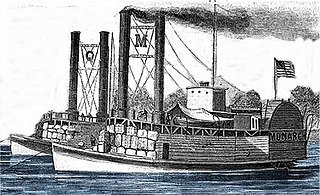
USS Monarch was a United States Army sidewheel ram that saw service in the American Civil War as part of the United States Ram Fleet and the Mississippi Marine Brigade. She operated on the Mississippi River and Yazoo River during 1862 and 1863.

USS General Bragg (1851) was a heavy (1,043-ton) steamer captured by Union Navy forces during the American Civil War. She was outfitted as a U.S. Navy gunboat and was assigned to enforce the Union blockade of the waterways of the Confederate States of America.

USS Signal (1862) – a small 190-ton steamship – was acquired during the second year of the American Civil War by the Union Navy and outfitted as a gunboat. She also served other types of duty, such as that of dispatch vessel and convoy escort.
The second Navy vessel to bear the name Sachem, this screw steamer was built in 1844 at New York City, where it was purchased by the Navy on 20 September 1861.
USS Rachel Seaman was a wooden schooner purchased by the Union Navy during the American Civil War.
USS Itasca was a Unadilla-class gunboat built for the U.S. Navy during the American Civil War. She was used by the Navy to patrol navigable waterways of the Confederacy to prevent the South from trading with other countries.

Little Rebel was a cotton-clad ram that had been converted from a Mississippi River steamer to serve as the flagship of the Confederate River Defense Fleet in the American Civil War. Sent from New Orleans to defend against the Federal descent of the Mississippi, she was among the force that engaged vessels of the Union Army's Western Gunboat Flotilla at the Battle of Plum Point Bend on May 10, 1862. On June 6, she again was involved in an action with the Federal gunboats, this time at the Battle of Memphis. In the battle, a shot from a Federal gun pierced her boiler, disabling her, and she was then pushed aground by the Federal ram USS Monarch and captured.
USS Granite City (1863) was a Confederate blockade runner steamer captured in March 1863 by the Union Navy during the American Civil War. She was armed with cannon and by August 1863 was in service as a gunboat in support of the Navy blockade of Confederate waters. She was recaptured in January 1864 by Confederate forces, again became a blockade runner, and ultimately was abandoned as a wreck after running aground.
USS Sallie Wood (1860) was a 256-ton steamer captured by the Union Navy during the early years of the American Civil War.
USS Sumter was a 525-ton sidewheel paddle steamer captured by the Union Navy during the Union blockade of the American Civil War.
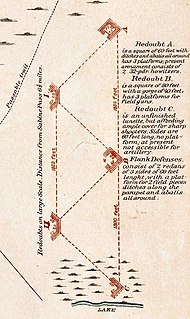
Fort Manhassett was a group of earthen fortifications that guarded the western approaches to Sabine City, Texas during the American Civil War, operating in service of the Confederate Army from October 1863 to May 1865.

Leon Smith was an American steamboat captain and soldier. In the American Civil War he served the Confederate States of America as a volunteer; he was named Commander of the Texas Marine Department under General John B. Magruder. Smith was involved in most major conflicts along the Texas coast during the war, and was described by war-time governor of Texas Francis Lubbock as "undoubtedly the ablest Confederate naval commander in the Gulf waters".
